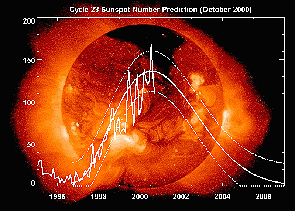Click on image for full size
Courtesy of NASA
Ulysses Going Strong During Solar Maximum
News story originally written on November 2, 2000
The Ulysses space probe has begun to investigate the Sun during solar maximum. In September of 2000, Ulysses began to creep around the underside of the Sun. Ulysses has passed this way before, but during solar minimum."Ulysses has been making continuous observations of the Sun and heliosphere for the last 10 years," said the U.S. project scientist for Ulysses, Dr. Edward Smith of NASA's Jet Propulsion Laboratory, Pasadena, California. "The scientists involved are still as enthusiastic as ever and are looking forward to discovering lots of new things as the Sun acts up."
Just what does Dr. Smith mean by the Sun acting up? Well, the Sun has an 11 year cycle from solar minimum to solar maximum and back to solar minimum. During solar minimum, the Sun is generally quiet, i.e., there is not a lot of solar activity. But during a solar maximum, there can be lots of activity! There are more sunspots during solar maximum and more likelihood of solar flares, prominences and coronal mass ejections. This activity can cause storms near the Earth that can damage our satellites, disrupt electronics on Earth, confuse animals or create awesome auroral displays.
The instruments aboard Ulysses studied the solar wind, the magnetic field of the Sun, the coronal layer of the Sun, and the make-up of the heliosphere during solar minimum (mainly 1994-1996). It will now fill in the gaps with data from a solar maximum period.
Ulysses is now observing the South pole region of the Sun. Its unique orbit allows it to do this. Ulysses sees the high solar latitudes, as far as 80 degrees North and South. That would be equivalent on Earth to traveling from the northern tip of Greenland to Antarctica
in the south.















